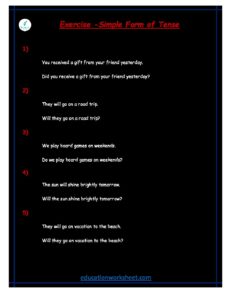changing Simple Tense to positive and interrogative
changing Simple Tense to positive and interrogative
Understanding how to convert simple tense sentences from their affirmative form to both positive and interrogative forms is a fundamental aspect of mastering the English language. The simple tense is one of the most basic and widely used grammatical constructs in English. It allows us to express actions or situations in a straightforward manner. By learning how to switch between positive and interrogative forms, you enhance your communication skills and ensure that you can convey your thoughts clearly and effectively.
In this comprehensive guide, we will explore the process of transforming simple tense sentences from their affirmative form into both positive and interrogative forms. We will delve into the key rules and patterns, offering a detailed explanation and providing examples along the way. By the end of this guide, you will have a solid understanding of how to manipulate simple tense sentences to express a wide range of meanings in English.
The Basics of Simple Tense

Before we delve into transforming simple tense sentences, let’s begin with a brief review of what the simple tense is and its three primary forms:
- Affirmative Form: This form states a fact or action in a positive manner. Example: She plays the piano.
- Negative Form: This form negates a fact or action. Example: She does not play the piano.
- Interrogative Form: This form asks questions about a fact or action. Example: Does she play the piano?
Section 2: Changing Simple Tense Sentences to Positive Form
Transforming simple tense sentences from negative or interrogative forms into positive form involves the following rules:
- Remove “do,” “does,” or “did” from the sentence (if present). Example:
- Negative: She does not like coffee. Positive: She likes coffee.
- Interrogative: Does he speak Spanish? Positive: He speaks Spanish.
- In the case of negative sentences, the word “not” is removed. Example:
- Negative: I do not want to go. Positive: I want to go.
Changing Simple Tense Sentences to Interrogative Form

Transforming simple tense sentences from affirmative or negative forms into interrogative form involves the following rules:
- Add “do,” “does,” or “did” to the beginning of the sentence. Example:
- Affirmative: She sings beautifully. Interrogative: Does she sing beautifully?
- Negative: He did not finish the project. Interrogative: Did he finish the project?
- In the case of negative sentences, the word “not” is placed after the auxiliary verb. Example:
- Negative: They do not like spicy food. Interrogative: Do they not like spicy food? (or Don’t they like spicy food?)
- For sentences that already begin with “do,” “does,” or “did” (in their negative form), simply switch the subject and the auxiliary verb. Example:
- Negative: Does she not enjoy swimming? Interrogative: Doesn’t she enjoy swimming?
Practice and Examples
To reinforce your understanding, let’s practice converting simple tense sentences into both positive and interrogative forms.
Example 1: Affirmative: He writes poetry. Negative: He does not write poetry. Interrogative: Does he write poetry?
Example 2: Negative: They don’t watch TV. Positive: They watch TV. Interrogative: Do they watch TV?
Example 3: Affirmative: She speaks French. Negative: She does not speak French. Interrogative: Does she speak French?
Example 4: Negative: I didn’t enjoy the movie. Positive: I enjoyed the movie. Interrogative: Did I enjoy the movie?
Example 5: Affirmative: They cook dinner together. Interrogative: Do they cook dinner together?
Example 6: Interrogative: Does she not like ice cream? Negative: She does not like ice cream.
Common Mistakes and Tips
changing Simple Tense to positive and interrogative

While converting simple tense sentences, it’s important to be aware of common mistakes and follow some essential tips:
- Ensure subject-verb agreement: Make sure the verb form agrees with the subject in terms of number and person.
- Correct: She likes pizza.
- Incorrect: She like pizza.
- Pay attention to the use of auxiliary verbs: Use the appropriate auxiliary verb (do, does, did) according to the subject and tense.
- Correct: I do my homework.
- Incorrect: I does my homework.
- Be cautious with contractions: In the negative form, contractions like “doesn’t” and “didn’t” are common in spoken English.
- Correct: She does not like coffee.
- Correct (contraction): She doesn’t like coffee.
- Invert subject and auxiliary verb in questions: Always place the auxiliary verb before the subject in interrogative sentences.
- Correct: Does he have a dog?
- Incorrect: He does have a dog?
- Maintain word order: Keep the word order consistent when converting sentences.
- Correct: They will arrive on time.
- Incorrect: Arrive will they on time.


